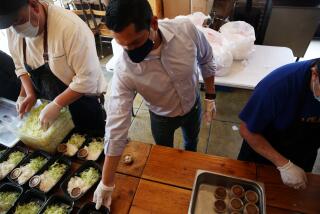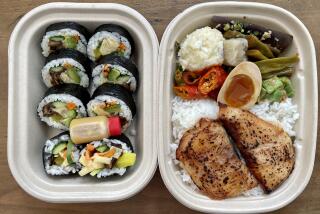In northwest Pasadena, access to healthful food is limited
Gripping plastic bags filled with milk, eggs and a two-liter bottle of orange soda, Itzel Hernandez made her way down Pasadena’s Orange Grove Avenue one recent evening, keeping a brisk pace and wearing a gray hoodie to keep away the fall chill.
Hernandez, 18, said she expected her trip home from Latino Market to take 25 minutes. The convenience store is the closest market to Hernandez’s home.
“Supermarkets aren’t that far if you have a car, but I don’t, so I have to walk,” Hernandez said. “We do have a McDonald’s and a Jack in the Box nearby, though.”
Hernandez’s shopping trip is common among northwest Pasadena residents, many of whom do not have cars and live close to fast-food restaurants and convenience stores but not supermarkets.
Northwest Pasadena has the traits of what nutrition experts call a food desert, defined by Congress as a lower-income neighborhood or community “with limited access to affordable and nutritious food.”
Northwest Pasadena has just three supermarkets — a Vons at Fair Oaks Avenue and Orange Grove Boulevard, a Food 4 Less at Lake Avenue and Washington Boulevard, and a Smart & Final on Fair Oaks and Maple Street — serving an area with 66,000 people. Overall, Pasadena has 19 supermarkets serving its 137,000 residents.
The lack of options leaves northwest Pasadena residents more vulnerable than others to obesity, high blood pressure and diabetes, according to health experts. A 2008 Pasadena Public Health Department study showed that the neighborhoods near northwest Pasadena schools offer little but fast food.
“There is a food desert issue up here,” said Mary Urtecho-Garcia, a nutrition and physical activity program coordinator for the Pasadena Public Health Department. Speaking from the agency’s northwest Pasadena office, she said, “The food establishments that are here are not catering to a healthy person. They’re catering to someone who wants more fast food.”
Urtecho-Garcia would like to see the gap filled with farmers markets and stores that offer more healthful choices.
But for now, there are convenience stores, small markets, liquor stores and fast-food restaurants.
“There’s food out there; there’s just not many healthful foods,” said Joyce Ann Gilbert, a professor of nutrition and food science at Cal State Northridge.
One in 4 Pasadena residents is obese, according to the city’s health department, roughly the same as the statewide rate.
In a study released last month, the state Department of Education found that teens in Pasadena have higher levels of obesity and score worse on physical agility tests than the average California teen.
“The obesity rate is throughout the city,” Urtecho-Garcia said. “But the concentration is here. The Latino population has less access to things.”
A 2009 Department of Agriculture study found that although proximity to healthful options helps to lower obesity rates, increased consumption of vegetables and fruits doesn’t automatically lead to a lower body fat percentage. People who eat healthful food may also continue to eat junk food.
Maria Puncino, a mother of five who lives in northwest Pasadena, said she goes to a fast-food restaurant twice a week, not because she wants to but because her kids demand it.
“They say, ‘If you don’t take me, I’m not going to eat,’” Puncino said.
Urtecho-Garcia said the health department makes an effort to reach people, doing studies such as the 2008 schools report and offering nutrition information in classrooms and at community meetings. In October, the City Council voted to ban unhealthful foods and drinks from vending machines on city property. But it is a challenge to get the message across.
The health department is aiming to find a vendor to run a farmers market in northwest Pasadena next year. It may also ask transportation officials to reroute public bus lines to better serve northwest Pasadena residents seeking more healthful options.
“We’re bringing in a farmers market, continuously doing nutrition education, and if we need to advocate for a different bus line, then we’ll do it,” Urtecho-Garcia said. “At the end of the day it’s about giving them the resources and the tools to make better decisions.”
More to Read
Start your day right
Sign up for Essential California for news, features and recommendations from the L.A. Times and beyond in your inbox six days a week.
You may occasionally receive promotional content from the Los Angeles Times.







